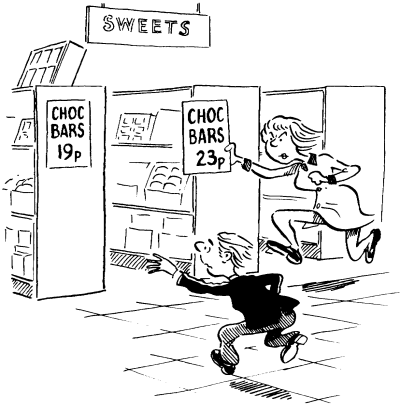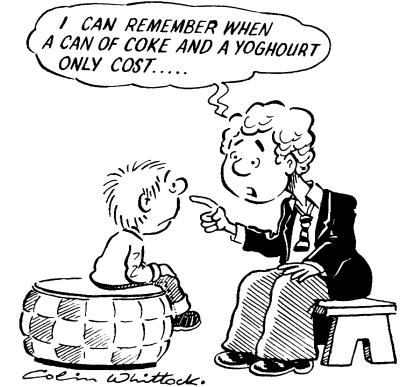|

In this unit work with prices in wholepence. Give your answers
correct to three significantfigures.
Price Rises
Discuss these questions:
Were things cheaper last rear?
Has anything not risen in price?
What has increased the most?
How much more pocket money do you need to buy the same things as
last year?
Individual Index Numbers
Table 1 shows some price
changes from 1977 to 1978.
- Write down the actual price increase of each item in Table 1.
- Which item has increased the most?
We can also compare price changes by finding the new price as
a percentage of the original price.
- How many bars of the chocolate would you get for 100p in
1977?
- How much would these same bars of chocolate cost in 1978?
For every 100p spent on chocolate in 1977 we would have to
spend 130p in 1978 to get the same amount. The 1978 price is 130
percent of the 1977 price.
Another way of working this out is to use:
1978 price/1977 price x
100
- Find the 1978 price as a percentage of the 1977 price for
the other three items in Table 1.
- Which item had the greatest percentage increase?
- Is your answer to f the same as your answer to b?
Can you explain?
The percentages ( 130 etc.) are called INDEX NUMBERS. The
first vear is called the BASE YEAR. All items have a price index
number of 100 in the base year.
With 1977 as the base year, the index number for chocolate in
1978 was 130.
- Copy the following sentence:
The index number is the number of pence you would pay now
for goods costing 100 pence in the base year.
- Write down the 1978 index number of each item in Table 1,
using 1977 as the base year.
Find out today's price of a can of Coca-Cola and a carton of
yoghourt. Using 1977 as the base year, work out:
- today's index number for a can of Coca-Cola,
- today's index number for a carton of yoghourt.

*Other Items
In each case 1978 index number = 1978 price/1977
price x 100
when 1977 is the base year.
- Copy the above statement.
- Find the l978 price index number for each of the six
items in Table 2, using 1977 as the base year. Give your
answers to the nearest whole number.
| Item |
1922 Price |
1978 Price |
| Disco |
30p |
35p |
| Fish and chips |
35p |
42p |
| Youth club |
10p |
13p |
| Swimming |
15p |
20p |
| Cinema |
60p |
65p |
| Calculator |
500p |
450p |
Table 2 - More price changes, 1977 to 1978.
- Which item rose the most in price?
- Which item has the greatest index number?
Pocket Money Price Index
Many of you have pocket money to spend on things for
yourselves each week. You may want to know how the prices of
things you buy regularly have increased in the past year.
Answer questions a to d in Table 7 on page R1.
- Choose three items you buy regularly. Write them in Table
7.
- Write in the prices for last year and this year.
- Find the total of last year's prices.
- Find the total of this year's prices.
This year's index number = This year's total/Last
year's total x 100 where last
year is the base year.
- Use this statement to rind this year's price index of
your three items.
- Copy and complete:
For every 100 pence spent last year, it cost pence to buy
these same items this year.
- Work out the index number for each individual item, and
put them in Table 7 on page R1.
- How does the combined index number compare with the three
individual indices?
- *How much was your pocket money last year?
- *How much is it this year?
- *Using last year as the base year, what is the index
number of this year's pocket money?
Grocery Prices
Your mother may he more concerned about grocery prices.
- Choose four foods you eat regularly at home from the list
on page R1.
- Enter these foods in Table 8 on page Rl, together with
their prices in 1977 and 1978.
- Find the index number of these four foods taken together,
with 1977 as the base year.
- *Make another selection of four foods, and find
theirindex number.
- Compare your results with those of a neighbour.
Are the index numbers different?
Write a sentence explaining why.
|